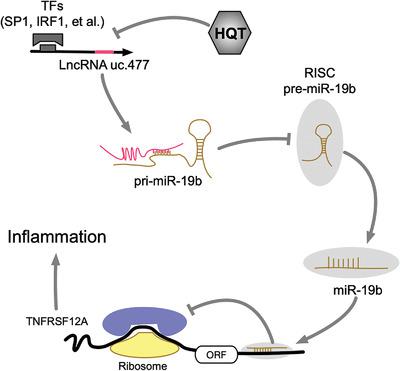当前位置:
X-MOL 学术
›
J. Leukoc. Biol.
›
论文详情
Our official English website, www.x-mol.net, welcomes your
feedback! (Note: you will need to create a separate account there.)
The mechanism of Chinese herbal formula HQT in the treatment of rheumatoid arthritis is related to its regulation of lncRNA uc.477 and miR-19b.
Journal of Leukocyte Biology ( IF 3.6 ) Pub Date : 2020-07-21 , DOI: 10.1002/jlb.3ma0620-441rrrr Maojie Wang 1 , Liyan Mei 1 , Zehao Liu 1 , Xuan Tang 1 , Xiaodong Wu 1 , Xiumin Chen 1 , Yue Zhao 1 , Qingchun Huang 1 , Runyue Huang 1, 2, 3
Journal of Leukocyte Biology ( IF 3.6 ) Pub Date : 2020-07-21 , DOI: 10.1002/jlb.3ma0620-441rrrr Maojie Wang 1 , Liyan Mei 1 , Zehao Liu 1 , Xuan Tang 1 , Xiaodong Wu 1 , Xiumin Chen 1 , Yue Zhao 1 , Qingchun Huang 1 , Runyue Huang 1, 2, 3
Affiliation

|
Rheumatoid arthritis (RA) pathogenesis has been associated with dysregulation of long noncoding RNA (lncRNA) and microRNA (miRNA) expression in serum and in lesioned tissue. In this study, a microarray assay was performed to study the profile of lncRNAs in the serum of RA patients and healthy donors, and a set of novel lncRNAs associated with RA was identified. For the remainder of the study, focus is on the top hit, lncRNA uc.477. The upregulation of lncRNA uc.477 and downregulation of miR‐19b were validated in the serum of RA patients compared to that of healthy donors, and similar results were further confirmed by quantitative real‐time PCR analysis of a cell line: RA‐derived human fibroblast‐like synoviocytes (HFLS‐RA). LncRNA uc.477 could interfere with the processing of pri‐miR‐19b to produce its mature form and thereby played a pro‐inflammatory role. In addition, Huayu Qiangshen Tongbi formula (HQT), a traditional Chinese medicine (TCM), has been shown to exert a promising therapeutic effect on RA and to exhibit long‐term safety in our previous clinical retrospective study. Importantly, HQT treatment normalized the levels of lncRNA uc.477 and miR‐19b in HFLS‐RA in vitro and in mouse models of collagen‐induced arthritis. HQT treatment, knockdown of lncRNA uc.477, and overexpression of miR‐19b resulted in a comparable inhibition of pro‐inflammatory cytokine gene expression in HFLS‐RA cells. Together, these data suggest that the therapeutic effects of HQT on RA are closely related to its modulation of lncRNA uc.477 and miR‐19b.
中文翻译:

中药方HQT治疗类风湿关节炎的机制与其对lncRNA uc.477和miR-19b的调控有关。
类风湿关节炎(RA)的发病机理与血清和病变组织中长非编码RNA(lncRNA)和microRNA(miRNA)表达失调有关。在这项研究中,进行了微阵列分析以研究RA患者和健康供体血清中lncRNA的概况,并鉴定出一组与RA相关的新型lncRNA。在其余的研究中,重点是热门的lncRNA uc.477。与健康供体相比,在RA患者血清中证实了lncRNA uc.477的上调和miR-19b的下调,并且通过实时定量PCR分析细胞系进一步证实了类似的结果:RA衍生的人成纤维样滑膜细胞(HFLS‐RA)。LncRNA uc。477可能会干扰pri-miR-19b的加工以产生其成熟形式,从而起到促炎作用。此外,在我们先前的临床回顾性研究中,中药“华宇强肾通痹方”(HQT)已被证明对RA具有良好的治疗作用,并具有长期安全性。重要的是,HQT治疗可在体外和胶原诱导的关节炎小鼠模型中使HFLS-RA中的lncRNA uc.477和miR-19b水平正常化。HQT处理,lncRNA uc.477的敲低和miR-19b的过表达导致HFLS-RA细胞中促炎性细胞因子基因表达的抑制作用相当。总之,这些数据表明,HQT对RA的治疗作用与其对lncRNA uc.477和miR-19b的调节密切相关。在我们以前的临床回顾性研究中,华中强肾通痹方(HQT)是一种中药(TCM),已显示出对RA的有效治疗作用,并具有长期安全性。重要的是,HQT治疗可在体外和胶原诱导的关节炎小鼠模型中使HFLS-RA中lncRNA uc.477和miR-19b的水平正常化。HQT处理,lncRNA uc.477的敲低和miR-19b的过表达导致HFLS-RA细胞中促炎性细胞因子基因表达的抑制作用相当。总之,这些数据表明,HQT对RA的治疗作用与其对lncRNA uc.477和miR-19b的调节密切相关。在我们以前的临床回顾性研究中,华中强肾通痹方(HQT)是一种中药(TCM),已显示出对RA的有效治疗作用,并具有长期安全性。重要的是,HQT治疗可在体外和胶原诱导的关节炎小鼠模型中使HFLS-RA中的lncRNA uc.477和miR-19b水平正常化。HQT处理,lncRNA uc.477的敲低和miR-19b的过表达导致HFLS-RA细胞中促炎性细胞因子基因表达的抑制作用相当。总之,这些数据表明,HQT对RA的治疗作用与其对lncRNA uc.477和miR-19b的调节密切相关。在我们先前的临床回顾性研究中,已显示出对RA产生有希望的治疗效果并显示出长期安全性。重要的是,HQT治疗可在体外和胶原诱导的关节炎小鼠模型中使HFLS-RA中lncRNA uc.477和miR-19b的水平正常化。HQT处理,lncRNA uc.477的敲低和miR-19b的过表达导致HFLS-RA细胞中促炎性细胞因子基因表达的抑制作用相当。总之,这些数据表明,HQT对RA的治疗作用与其对lncRNA uc.477和miR-19b的调节密切相关。在我们先前的临床回顾性研究中,已显示出对RA产生有希望的治疗效果并显示出长期安全性。重要的是,HQT治疗可在体外和胶原诱导的关节炎小鼠模型中使HFLS-RA中lncRNA uc.477和miR-19b的水平正常化。HQT处理,lncRNA uc.477的敲低和miR-19b的过表达导致HFLS-RA细胞中促炎性细胞因子基因表达的抑制作用相当。总之,这些数据表明,HQT对RA的治疗作用与其对lncRNA uc.477和miR-19b的调节密切相关。miR-19b的过度表达导致HFLS-RA细胞中促炎性细胞因子基因表达的抑制作用相当。总之,这些数据表明,HQT对RA的治疗作用与其对lncRNA uc.477和miR-19b的调节密切相关。miR-19b的过度表达导致HFLS-RA细胞中促炎性细胞因子基因表达的抑制作用相当。总之,这些数据表明,HQT对RA的治疗作用与其对lncRNA uc.477和miR-19b的调节密切相关。
更新日期:2020-08-04
中文翻译:

中药方HQT治疗类风湿关节炎的机制与其对lncRNA uc.477和miR-19b的调控有关。
类风湿关节炎(RA)的发病机理与血清和病变组织中长非编码RNA(lncRNA)和microRNA(miRNA)表达失调有关。在这项研究中,进行了微阵列分析以研究RA患者和健康供体血清中lncRNA的概况,并鉴定出一组与RA相关的新型lncRNA。在其余的研究中,重点是热门的lncRNA uc.477。与健康供体相比,在RA患者血清中证实了lncRNA uc.477的上调和miR-19b的下调,并且通过实时定量PCR分析细胞系进一步证实了类似的结果:RA衍生的人成纤维样滑膜细胞(HFLS‐RA)。LncRNA uc。477可能会干扰pri-miR-19b的加工以产生其成熟形式,从而起到促炎作用。此外,在我们先前的临床回顾性研究中,中药“华宇强肾通痹方”(HQT)已被证明对RA具有良好的治疗作用,并具有长期安全性。重要的是,HQT治疗可在体外和胶原诱导的关节炎小鼠模型中使HFLS-RA中的lncRNA uc.477和miR-19b水平正常化。HQT处理,lncRNA uc.477的敲低和miR-19b的过表达导致HFLS-RA细胞中促炎性细胞因子基因表达的抑制作用相当。总之,这些数据表明,HQT对RA的治疗作用与其对lncRNA uc.477和miR-19b的调节密切相关。在我们以前的临床回顾性研究中,华中强肾通痹方(HQT)是一种中药(TCM),已显示出对RA的有效治疗作用,并具有长期安全性。重要的是,HQT治疗可在体外和胶原诱导的关节炎小鼠模型中使HFLS-RA中lncRNA uc.477和miR-19b的水平正常化。HQT处理,lncRNA uc.477的敲低和miR-19b的过表达导致HFLS-RA细胞中促炎性细胞因子基因表达的抑制作用相当。总之,这些数据表明,HQT对RA的治疗作用与其对lncRNA uc.477和miR-19b的调节密切相关。在我们以前的临床回顾性研究中,华中强肾通痹方(HQT)是一种中药(TCM),已显示出对RA的有效治疗作用,并具有长期安全性。重要的是,HQT治疗可在体外和胶原诱导的关节炎小鼠模型中使HFLS-RA中的lncRNA uc.477和miR-19b水平正常化。HQT处理,lncRNA uc.477的敲低和miR-19b的过表达导致HFLS-RA细胞中促炎性细胞因子基因表达的抑制作用相当。总之,这些数据表明,HQT对RA的治疗作用与其对lncRNA uc.477和miR-19b的调节密切相关。在我们先前的临床回顾性研究中,已显示出对RA产生有希望的治疗效果并显示出长期安全性。重要的是,HQT治疗可在体外和胶原诱导的关节炎小鼠模型中使HFLS-RA中lncRNA uc.477和miR-19b的水平正常化。HQT处理,lncRNA uc.477的敲低和miR-19b的过表达导致HFLS-RA细胞中促炎性细胞因子基因表达的抑制作用相当。总之,这些数据表明,HQT对RA的治疗作用与其对lncRNA uc.477和miR-19b的调节密切相关。在我们先前的临床回顾性研究中,已显示出对RA产生有希望的治疗效果并显示出长期安全性。重要的是,HQT治疗可在体外和胶原诱导的关节炎小鼠模型中使HFLS-RA中lncRNA uc.477和miR-19b的水平正常化。HQT处理,lncRNA uc.477的敲低和miR-19b的过表达导致HFLS-RA细胞中促炎性细胞因子基因表达的抑制作用相当。总之,这些数据表明,HQT对RA的治疗作用与其对lncRNA uc.477和miR-19b的调节密切相关。miR-19b的过度表达导致HFLS-RA细胞中促炎性细胞因子基因表达的抑制作用相当。总之,这些数据表明,HQT对RA的治疗作用与其对lncRNA uc.477和miR-19b的调节密切相关。miR-19b的过度表达导致HFLS-RA细胞中促炎性细胞因子基因表达的抑制作用相当。总之,这些数据表明,HQT对RA的治疗作用与其对lncRNA uc.477和miR-19b的调节密切相关。











































 京公网安备 11010802027423号
京公网安备 11010802027423号